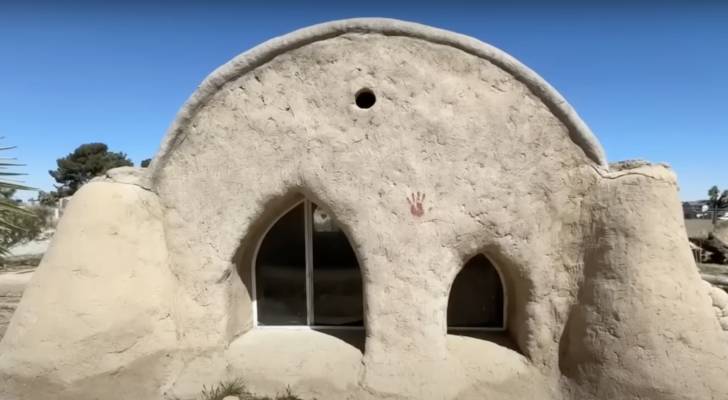
In the wake of destruction from the January wildfires, some residents in Greater Los Angeles are looking to build back better. And, for some, that means turning to the past for future solutions.
Don’t miss
- I’m 49 years old and have nothing saved for retirement — what should I do? Don’t panic. Here are 5 of the easiest ways you can catch up (and fast)
- You’re probably already overpaying for this 1 ‘must-have’ expense — and thanks to Trump’s tariffs, your monthly bill could soar even higher. Here’s how 2 minutes can protect your wallet right now
- Gain potential quarterly income through this $1B private real estate fund — even if you’re not a millionaire. Here’s how to get started with as little as $10
Ellen Snortland and her husband have now lost a home to fire, another to flooding and another to a mudslide — and they’re tired of fighting the elements.
“We are going to have to deal with extreme weather for the rest of our lives. To pretend otherwise is really folly,” Snortland told KCAL News. “I don’t see anybody doing anything radical. So what I can do is make my home radical.”
Radical how? SuperAdobe, developed by a company called CalEarth, is a form of architecture that uses long sandbags, barbed wire and earth, which the company says can withstand fire, flooding, earthquakes and even hurricanes. Think of it as adobe 2.0.
“The key is not the usage of material so much, but the understanding of geometry and forces of physics,” said late founder Nader Khalili to The Earth & I.
The need for fire-resistant homes is only going to increase as the frequency and severity of wildfires continues to increase. So far this year, 24,415 fires have burned through more than a million acres across the U.S., both significantly above the 10-year average, according to the National Interagency Fire Center.
What’s so super about SuperAdobe
During the Eaton fire, Snortland watched her home burn on TV. Now she’s ready to rebuild — literally using the dirt on her property.
It’s why she came to an open house by CalEarth, a nonprofit founded by an Iranian architect who developed SuperAdobe based on traditional adobe architecture from his home in Iran.
Bridget Butler, executive director of the CalEarth Institute, told KCAL News that every CalEarth open house has been sold out since the fires. During the open house, they showcase the dome-shaped rooms, which she said are harder to shake, burn or wash away.
“The arch shape is the strongest shape in nature,” said Butler. “Instead of working against nature, it’s trying to beat nature at its own game.”
According to the website, the long coils of sandbags provide compression (vertical) strength and the barbed wire adds tensile (horizontal) strength.
If you’re so inclined, you could even build the house yourself and save on labor costs. SuperAdobe rolls start at $445 for 250 yards. They are sold in conjunction with CalEarth’s training courses.
A SuperAdobe home can last several years, according to CalEarth, but to make them permanent you’ll need to plaster over the sandbag structure to protect it from erosion.
It’s unclear how having such a home would affect your home insurance policy.
Read more: Want an extra $1,300,000 when you retire? Dave Ramsey says this 7-step plan ‘works every single time’ to kill debt, get rich in America — and that ‘anyone’ can do it
The movement towards safer homes
The concept of earthen homes has been around for thousands of years. Indigenous communities in what is now New Mexico and Colorado, for example, have used adobe for centuries, keeping their homes cool in summer and warm in winter.
In the aftermath of the L.A. wildfires, advocates for natural building techniques argue that materials like adobe and cob (which use sand, clay and straw) not only offer fire-resistance, but are also more environmentally friendly — reducing toxic hazards associated with more modern building materials.
Asbestos, for example, was more recently used for its fire-retardant properties, but exposure can create health issues, such as an increased risk of developing lung disease.
This shift reflects a growing awareness of the need for resilient and environmentally friendly construction practices in fire-prone regions.
Not everyone is going to build an earthen home, but it’s possible to retrofit a home to reduce vulnerability to wildfire — and some of those measures are affordable. In a paper by Headwaters Economics on retrofitting a home for wildfire resistance, the authors say that costs can range anywhere from $2,000 for minimal retrofits to more than $100,000 (for a typical 2,000-square-foot home in California).
Some of these measures include replacing exterior vents with flame- and ember-resistant vents, installing metal gutter guards and replacing bark mulch with gravel, according to the paper.
California’s Safer from Wildfires initiative lists steps you can take to qualify for an insurance discount.
What to read next
- Don’t have the cash to pay Uncle Sam in 2025? You may already be eligible for a ‘streamlined’ handshake with the IRS — here’s how it works and how it can potentially save you thousands
- Robert Kiyosaki warns of a ‘Greater Depression’ coming to the US — with millions of Americans going poor. But he says these 2 ‘easy-money’ assets will bring in ‘great wealth’. How to get in now
- Here are 5 ‘must have’ items that Americans (almost) always overpay for — and very quickly regret. How many are hurting you?
This article provides information only and should not be construed as advice. It is provided without warranty of any kind.